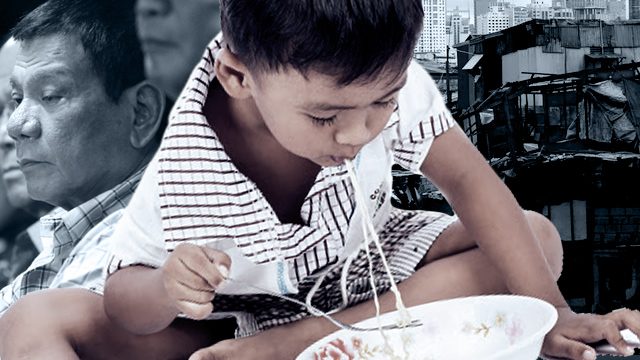SUMMARY
This is AI generated summarization, which may have errors. For context, always refer to the full article.

MANILA, Philippines – With the “unprecedented” rise of stunting rates in the country, government officials urged the Duterte administration to give malnutrition the same amount of attention it has given illegal drugs in the past months.
“It cannot be business as usual, which has been the practice for several administrations now. If you read the news, you will see that the government says 27% of our barangays have a problem with illegal drugs,” Cecilia Acuin, chief science research specialist at the Department of Science and Technology’s Food and Nutrition Research Institute, said on Tuesday, August 30.
She added: “I’m not belittling the problem. It’s illegal drug use, it’s a very important problem of our country. But when you compare that to [the fact that 78%] of barangays have at least one undernourished child, I think you will agree with me that this problem of undernutrition requires much attention, if not more.”
A report by non-governmental organization Save the Children revealed on Tuesday that the Philippines is losing at least P328 billion ($7.06 billion) a year due to the impact of childhood stunting on education and workforce productivity.
Acuin, who reacted to the Save the Children report, told Rappler that out of the 42,036 barangays in the country, 72% have at least one stunted children, 31% have at least one wasted child, and 60% have at least one underweight child.
About 78% of the barangays have at least one undernourished child who is either stunted, wasted, or underweight. Acuin said most of these barangays are located in the Autonomous Region in Muslim Mindanao, Mimaropa, Eastern Visayas, Bicol, and Zamboanga Peninsula.
“Those are the areas with the highest rates of undernutrition. Kulang ang services, kulang ang pagkain, napaka-unstable ng environment, napaka-harsh ng environment, saka marami rin silang feeding practices [na] hindi masyadong contributing to good nutrition,” she explained.
(Those are the areas with the highest rates of undernutrition. They lack services, they lack food, the environment is very unstable, very harsh, and they have feeding practices that do not contribute much to good nutrition.)
‘Time to prioritize undernutrition’
Ned Olney, country director of Save the Children Philippines, told Rappler that nutrition has not been “enunciated as a major policy priority” of the Duterte administration.
“I do know that it’s a priority for the Department of Health. I have not yet heard or seen other departments or at the Malacañang level that they’re focusing… I know there [are] a lot of priorities,” he added.
Acuin said it’s time for both government and civil society to prioritize undernutrition. (READ: National survey: Chronic malnutrition in PH worst in 10 years)
“Kasi ‘yung consequences niyan, lahat naman tayo nagsu-suffer (Because all of us suffer its consequences). In the same way that the drug problem also affects all of us, but the case for malnutrition is just as compelling, so we would like to urge the government to also give it as much attention,” she said.
The Duterte administration has intensified its crackdown on illegal drugs, with a campaign that has seen 895 alleged drug suspects killed in police operations, and the surrender of 626,556 alleged drug addicts. (READ: War on drugs: Rehabilitation must be more than a knee-jerk reaction)
Both Acuin and Olney are alarmed by the rise of stunting rates in the country: there are currently 3.8 million stunted children in the Philippines, an increase from the 3.2 million in 2013. (READ: 12M of stunted children in ASEAN live in PH, Indonesia – report)
Olney called the rise “unprecedented”, since stunting rates in the country have been “fairly steady” for the last 10 years.
Stunted growth – a sign of chronic malnutrition – could affect a child’s cognitive development, overall health, and even socio-economic conditions that carry on to adulthood.
With 33% childhood stunting nationwide, Olney said the Philippines is now ranked 9th in the world in terms of total number of stunted children. – Rappler.com
Add a comment
How does this make you feel?
There are no comments yet. Add your comment to start the conversation.